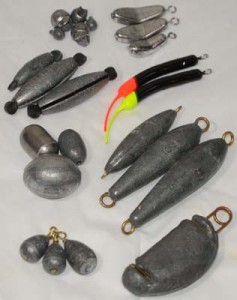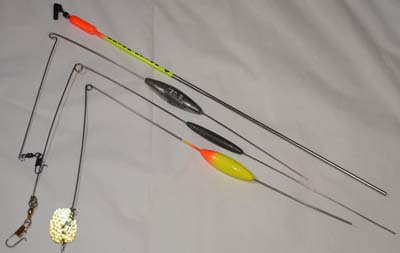The different types of sinkers all have one common theme, to take your bait down to where the fish are. There is a wide array of ways that they accomplish this and not all of them are intuitive. Below is a list of a variety of sinker types along with some tips for there use.
1) Spit Shot (Reusable and Non-Reusable)
This is about as simple as they get, gently close the sinker on the line at a desired distance from the bait. They can also be used as a stop for a larger sliding sinker. Couple of tips:
A) Not all spit shot is created equal. Softer lead such as that from Water Gremlin can often be applied to your line with finger pressure only. This not only saves time (by not needing to grab the pliers) but the soft lead is less likely to damage your line. I’ve had trouble with many brands of split shot that were extremely hard to work with and caused weakening of the line when they needed to be crimped onto the line using pliers.
B) If more weight is needed its better to use one larger weight than it is to use multiple weights strung together. Multiple weights tend to tangle around each other causing knots to form in the line. Sometimes, in heavier current, more weight is needed and a second (or third) weight must be added. In this case try placing the weight solidly against each other to help mitigate knot formation.
C) Reusable weights make for easy adjustment of the amount of weight and are pretty much the only type I use except when I’m drift fishing for steelhead or nymph fishing for trout (a fly fishing technique) as the clear water mandates as small a profile a possible. The non-reusable type may also be just a little less likely to snag or pick up weeds.

From top left clockwise: split shot, walking sinkers, Lindy No-Snagg sinkers, in-line trolling sinkers, releasable line weight, drop or bell sinkers, egg type slip sinkers, rubber core sinkers
2) Rubber Core Sinkers
Attach to line through the slot in the sinker and the twisting rubber core secures it in place. Can be added and removed quickly without damage to the line although I find that with lighter line there can be issues with line twist in current.
3) Egg/Slip Sinkers
A good way to get a bait to the bottom yet allow the fish to take the bait with little to no resistance. Put the line through the sinker and tie the end to a swivel. Add a length of leader line to your bait on a hook or floating jig head. Some people also like to add a small bead between the weight and the swivel to protect the knot. You can also use a small split shot as a weight stop, forgoing the swivel with the hook tied directly to the main line. I do find the the split shot will slid down the line when heavier sliding weights are used. The swivel also reduces line twist in current or when drifting or trolling.
4) Drop Sinkers (Bell Sinkers)
As the name implies a useful weight for a drop sinker setup where the hook/lure is tied on above the weight (which drops down a certain distance). Good for straight down presentations where you want to keep the bait a certain distance above the bottom.
5) Walking Sinkers
Designed for use with a Lindy rig setup. A good option for sandy or mud bottom areas. For snag infested waters see number 6.
6) Lindy No-Snagg Sinkers
A new favorite of mine. The shape of these really do help cut down on snags, they are not snag-proof though and do require you pay attention to changes in structure at the bottom. I generally tie them “Lindy Rig” style with a heavier main line, swivel and lighter fluorocarbon leader. Many times the snags that occur are to the hook and with a lighter leader and heavier main line you can break off snags at the hook, saving your swivel and sinker.
7) In-Line Trolling Sinkers
The name pretty much says it all. Attach to a good ball bearing swivel on the main line. Tie on a length of leader line to a lure directly or to another swivel and lure (better if you are changing lures trying to find what is working). More weight = greater depth.
8) Releasable Line Weights
These weights are an interesting take on a “poor man’s downrigger”. The weight hangs on the line using two wires and also clips to the line with a wire line release. Good for trolling lures at deeper depths. When a fish is on a quick hook set type pull on the line releases the weight which then slides down to the lure allowing for a better fight with the fish. I used to use these with some success for rainbow trout in Georgian Bay. I do believe though that now Dipsy Divers are a better and more consistent option to hold your lure at depth if you don’t have access to a downrigger.
9) Bottom Bouncer and Variants
These ingenious class of weights allow you to slowly troll a lure or live bait rig just off the bottom while bouncing over most snags. Some variants include added “shaky” blades and walking stick types. A must have presentation for bottom relating fish such as walleye.




Pingback: Drop Shotting » The Scientific Fisherman